Network players are different: black, white, ASUS ...
ASUS is once again going to bake delicious pancakes;) This time, she swung at the network media player market.
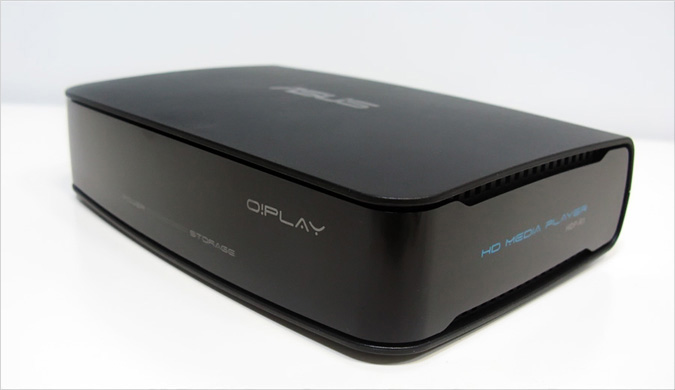
I share the recipe.
The release of this player suggests that the market for such devices is already large enough (which are only some Twixes and corn), so that large players like ASUS can enter it. Although it is too late, but there is still much to sell - these devices are gaining more and more popularity among ordinary users.
')
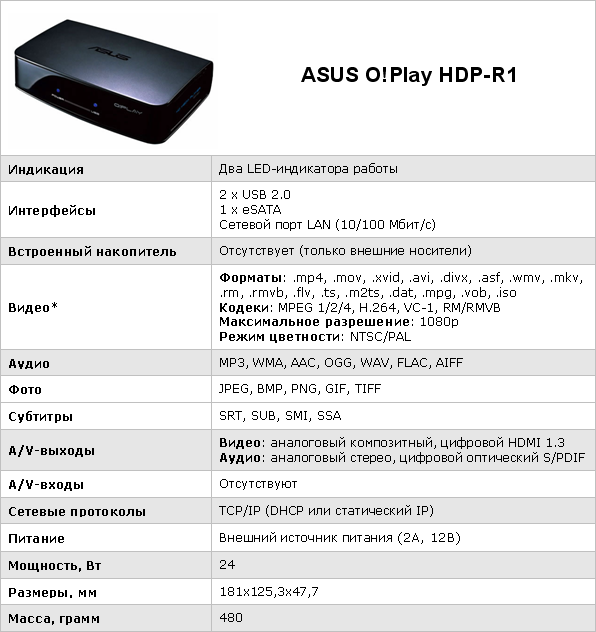
The size of the color box can be seen in the photo. In a very modest size fit:
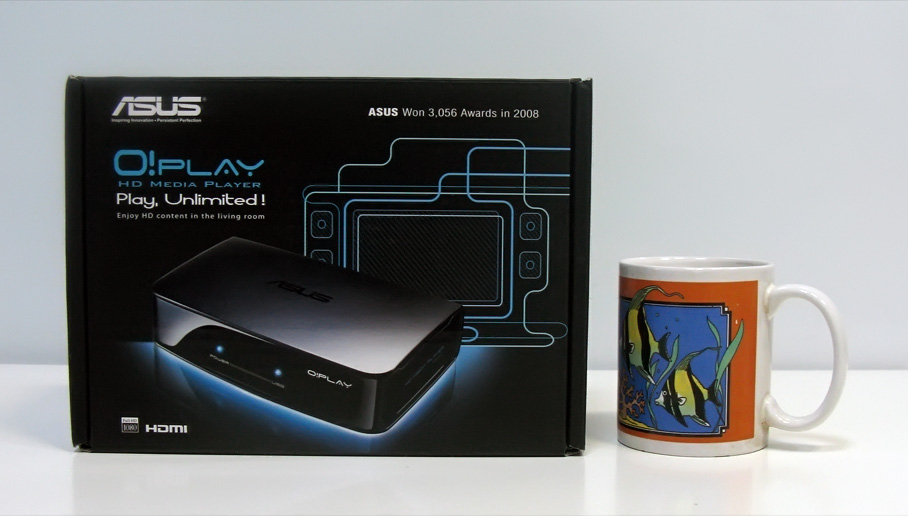
- Network player ASUS O! Play ;
- AC adapter (2A, 12V);
- Remote control + 2xAAA;
- Quick Installation Guide;
- A / V cable;
- CD.
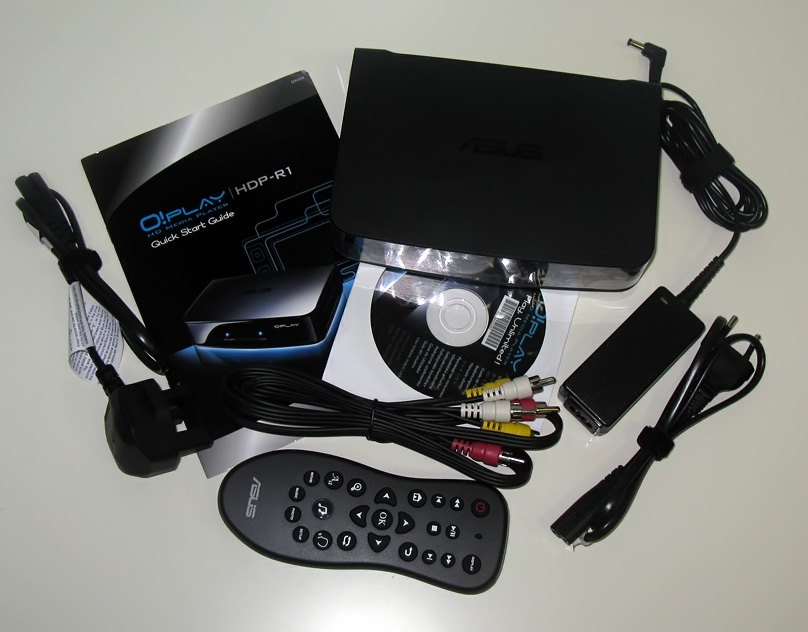
The full name of the device - ASUS O! Play HDP-R1 , so that it is always easy to find it in the search - you will not be confused with anything. Manual in different languages, including Russian.
On the disc - Russian-language manual in PDF format. Velcro on wires can be a pleasant trifle - for neat stacking or “braids”.
The player is somewhat different in appearance from its predecessors, and to the last it seems that there is still a hard drive installed. However, it is not there) The case is small, made of black matte plastic (although the front side still contains a bit of gloss - behind this “half-glass” case part there is an IR receiver and two blue LEDs of medium brightness).
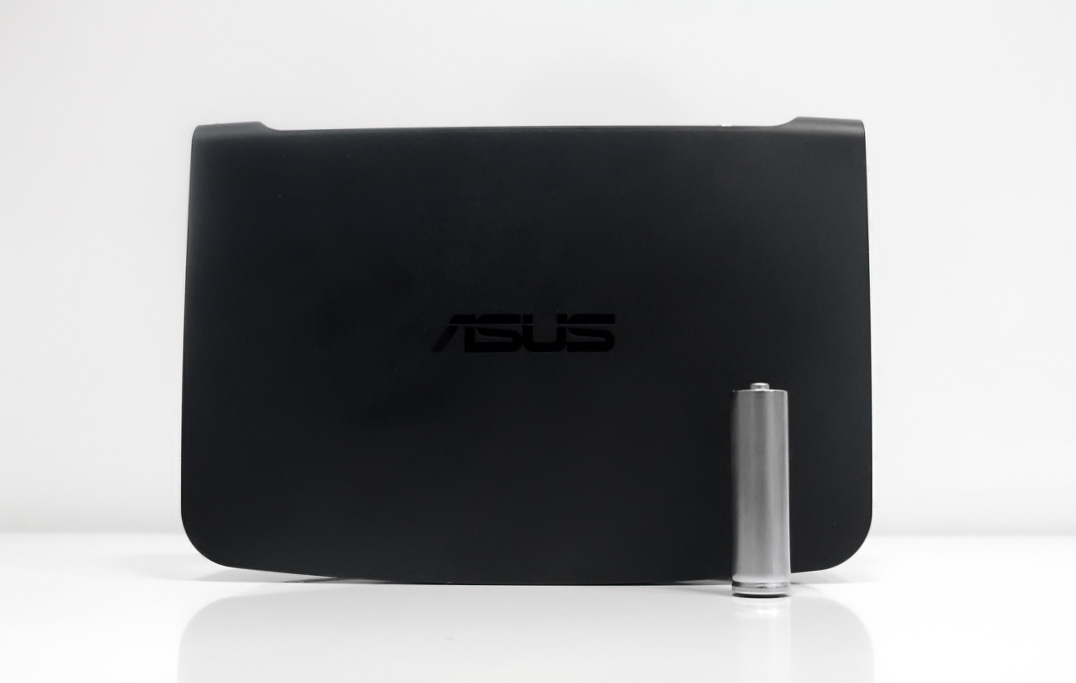

On the back side are almost all the connectors - despite the fact that HD-video is best suited for HDMI (here it is 1.3), without a component video output it is somehow just empty. In addition to HDMI, there is also a power connector and a network port, stereo audio and digital optical output.

At one end there are two USB ports (2.0), one of which is combined with an eSATA connector.
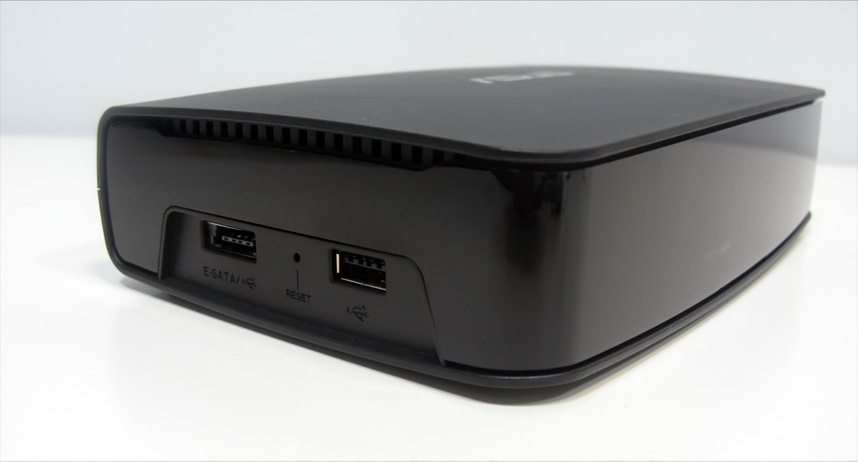
I did not carry out the opening of the device, but, according to the reviews available on the network, there is one single shielded printed circuit board on which the multimedia processor Realtek RTD1073 is installed at 400 MHz .

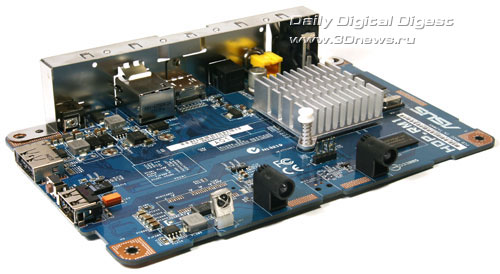
(These two images are taken from a review on the 3DNews website)
Judging by the specifications , HD video should be fully supported up to 1080 @ 60p. In the same place, by the way, I was embarrassed by the line “ It supports a wireless LAN IEEE 802.11b / g / n in-house total solution ” - although nothing is said about the work on wifi.

As for the power supply - as you may have noticed, it is external. Why, with such dimensions of the device and in the absence of a disk inside, the power supply had to be brought out nevertheless - I guess. I think he would not particularly disturb the “greenhouse conditions” inside, although the absence of noise from passive cooling is always a pleasant bonus. Well, at least the block itself is quite small - exactly the same as on netbooks.
Remote ... such a remote. When we first met, he seemed like a very Chinese children's toy - a plastic craft with a couple of big rubber buttons. But only after you take it in your hands and “click the channels” for a couple of minutes, you realize how comfortable it is. First, it is very small - even the smallest hand will reach for any of its buttons. Secondly, it has a very relief case - it will not work out. Thirdly, it does not have a frightening number of buttons - just what you really need. Well and fourthly - tactile buttons are pressed very nicely.

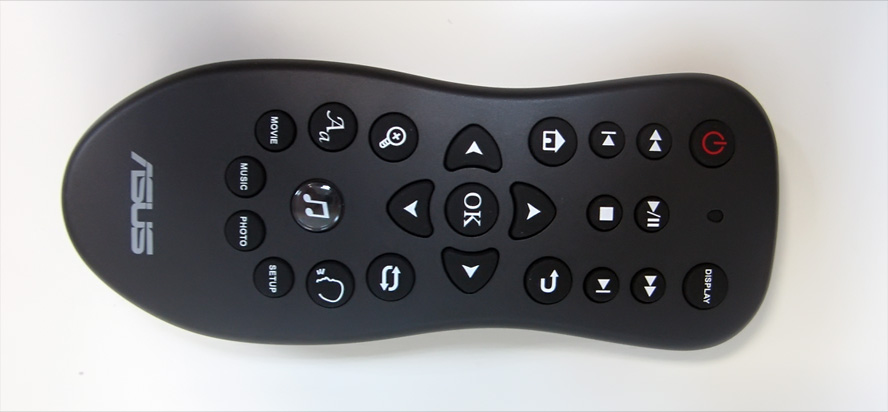
When you first start, you need to make some settings - language, hdmi mode, network settings (it worked with DHCP). Later, the player enters the ready-to-work state in 10 seconds - right after that, a beautiful color menu appears in front of the user on the TV screen. Well, as beautiful ... much prettier than in many other players, but otherwise it is the simplest. It provides 5 items (placed in the "carousel") - movies , music , photos , copying files and settings . The carousel is spinning fast, without any brakes and delays.
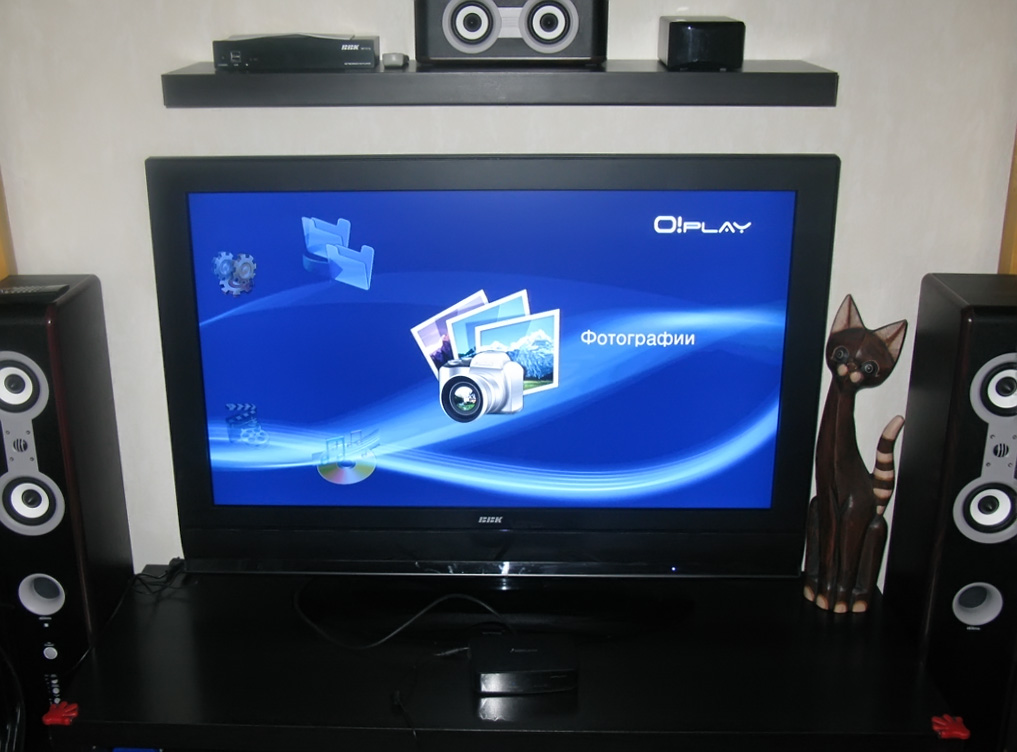
In the settings window there are 5 tabs available - sound , video , photos , network and system .
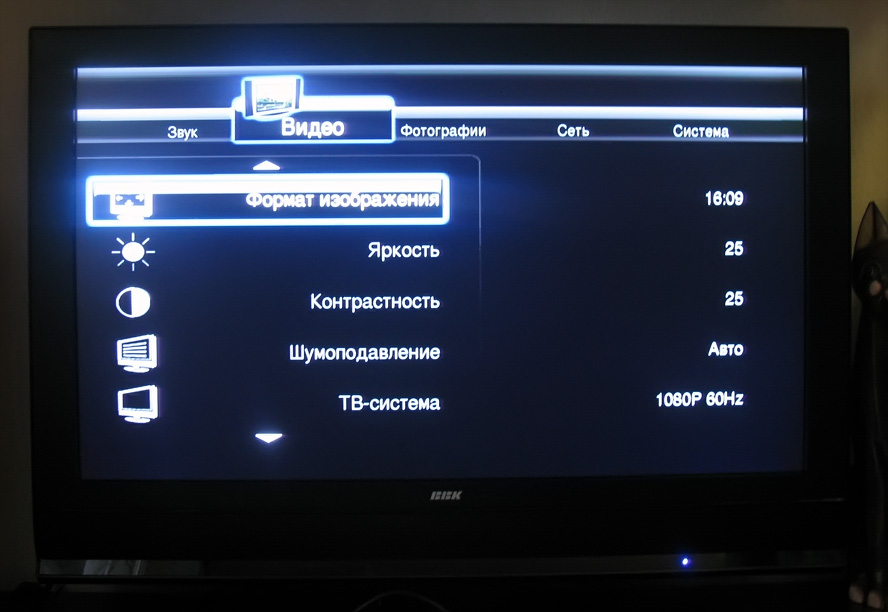
Switching between them occurs just as without brakes, which is very nice (although in everyday life you will not come here so often). Settings do not spoil their number - you can customize the screen format, video output mode, brightness, contrast, effect (as much as 8) and frame interval when watching a slide show, encoding / subtitle language, system language and something else there - nothing non-standard for players. Most likely, everything will work without additional user intervention, but in any case, difficulties are unlikely to arise. All menus are well Russified.
The source of media content can be media like flash drives and external hard drives (FS - FAT32 / NTFS / HFS +) - through USB and eSATA ports. But the function of viewing files over the network seems more interesting to me. Working through SMB / CIFS protocols, the player is able to downloadbare aunt movies at speeds up to 33 Mbps (at least through my 100-megabit router) - an average fountain power, but this is quite enough for many films whose weight is not tens of gigabytes. . You can get full telnet access to the device system.
On the remote there are a couple of buttons that allow you to select the desired type of content, bypassing the main menu - in fact, the usual file filters. In the case of a photo, they look very nice and quickly switch through hdmi on a large panel, but with a turn and scale of business a bit slower. You can put music in order and go to another menu - it will play.
Music plays, but no frills - there is a rewind (up to 32x), tags were read only from mp3 files and occasionally with Cyrillic script.

Watching the video I was pleasantly surprised. Despite the fact that the player is playing from the network (i.e., in fact, downloading a movie, rather than storing it on a disk within itself), I did not encounter any artifacts. Even when rewinding - in most cases, everything is smooth, even with very large files (40 gig movies did not have time to try). The usual 700-megovid video player clicks like nuts (in such files I have most cartoons, including the ancients). In all the specifications of the device that I have met, it is not said anywhere that the player can play DVD-video from ISO-images, which also can be found in our time.
The player itself consumes about 10W, the rest of the power supply unit is designed for external devices. Despite the lack of a cooler, the device even after long work remains barely warm.
For our short time that we were together, the player never hung up and generally left only positive memories :) Now I suggest everyone to get acquainted with the recorded video, which shows the operation of the device. The sound is terrible - did not replace it, because part of the video "voiced" by the music of the device itself:
I repeat that the device can be easily reflashed by correcting bugs and adding new functionality. I myself did not have time to do this, but there is a lot of discussion on the forums on this topic.
By the way, an interesting picture was suddenly found in the open spaces of the network:

pros
- Compact size;
- Minimalistic design, including a convenient remote control;
- Several interfaces for external media (USB, eSATA, LAN) and quick work with them;
- Work with Windows 7 and file systems FAT32, NTFS, HFS +;
- Quick navigation through a very nice player menu;
- Support for a large number of file formats;
- Ability to increase the functionality of the firmware;
- Price!
Minuses
- No HDMI cable included;
- Built-in hard disk would give more options;
- A couple of times there were shoals with tags of music files;
- Does not work over a Wi-Fi network and does not download torrents.
At Yandex.market, at the time of writing this review, the device is still being positioned as a novelty, however, the price is not biting at all - 4,500 rubles. Perhaps for someone such a decision would be a good gift for the New Year tree.
Price dynamics:
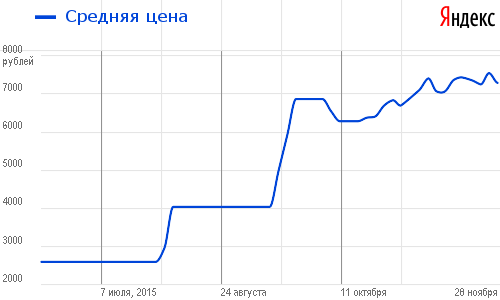
Considering that there were already a lot of various media solutions, the company chose, in my opinion, the right way - it released a functional device with an attractive pricing policy. This, in fact, took all the minimalism and simplicity that are inherent in this device, plastic instead of luminium, etc.
Despite the fact that for the company it is, in fact, the first experience in designing such devices, the pancake did not turn out to be lumpy. It may not be suitable for creating a serious home theater system, but it is ideal for a number of everyday tasks. The speed of the player has surpassed all those devices that I met before; and the Internet whispers that this is generally one of the fastest players on the market. Given the cost of the device, choosing a worthy (and affordable in our market) competitor becomes even more difficult even among the “Chinese”.
If we take into account all the above, we can assume that the player will be interesting for a fairly large audience of users. The device is not perfect (like everything in this world) - there are also very significant drawbacks. But the reputation of the manufacturer hints that many of the shortcomings will be eliminated, and the functionality expanded. I think that what cannot be eliminated programmatically will soon be realized in a new device - for example, in a new O! Play Air HDP-R3, which is already in a hurry to change to a younger brother. Apparently, this is no less tasty dish from gourmets from ASUS, so that Chinese manufacturers of media players will have to push aside.
 Feel free to join the ranks of fans of the company;)
Feel free to join the ranks of fans of the company;)
Successes and with the coming!

I share the recipe.
The release of this player suggests that the market for such devices is already large enough (which are only some Twixes and corn), so that large players like ASUS can enter it. Although it is too late, but there is still much to sell - these devices are gaining more and more popularity among ordinary users.
')
Speck *

* There are new firmware - for example, BD-images are already fully coming.
Equipment
The size of the color box can be seen in the photo. In a very modest size fit:

- Network player ASUS O! Play ;
- AC adapter (2A, 12V);
- Remote control + 2xAAA;
- Quick Installation Guide;
- A / V cable;
- CD.

The full name of the device - ASUS O! Play HDP-R1 , so that it is always easy to find it in the search - you will not be confused with anything. Manual in different languages, including Russian.
On the disc - Russian-language manual in PDF format. Velcro on wires can be a pleasant trifle - for neat stacking or “braids”.
Appearance
The player is somewhat different in appearance from its predecessors, and to the last it seems that there is still a hard drive installed. However, it is not there) The case is small, made of black matte plastic (although the front side still contains a bit of gloss - behind this “half-glass” case part there is an IR receiver and two blue LEDs of medium brightness).


On the back side are almost all the connectors - despite the fact that HD-video is best suited for HDMI (here it is 1.3), without a component video output it is somehow just empty. In addition to HDMI, there is also a power connector and a network port, stereo audio and digital optical output.

At one end there are two USB ports (2.0), one of which is combined with an eSATA connector.

I did not carry out the opening of the device, but, according to the reviews available on the network, there is one single shielded printed circuit board on which the multimedia processor Realtek RTD1073 is installed at 400 MHz .


(These two images are taken from a review on the 3DNews website)
Judging by the specifications , HD video should be fully supported up to 1080 @ 60p. In the same place, by the way, I was embarrassed by the line “ It supports a wireless LAN IEEE 802.11b / g / n in-house total solution ” - although nothing is said about the work on wifi.

As for the power supply - as you may have noticed, it is external. Why, with such dimensions of the device and in the absence of a disk inside, the power supply had to be brought out nevertheless - I guess. I think he would not particularly disturb the “greenhouse conditions” inside, although the absence of noise from passive cooling is always a pleasant bonus. Well, at least the block itself is quite small - exactly the same as on netbooks.
Remote ... such a remote. When we first met, he seemed like a very Chinese children's toy - a plastic craft with a couple of big rubber buttons. But only after you take it in your hands and “click the channels” for a couple of minutes, you realize how comfortable it is. First, it is very small - even the smallest hand will reach for any of its buttons. Secondly, it has a very relief case - it will not work out. Thirdly, it does not have a frightening number of buttons - just what you really need. Well and fourthly - tactile buttons are pressed very nicely.


Turn on and work
When you first start, you need to make some settings - language, hdmi mode, network settings (it worked with DHCP). Later, the player enters the ready-to-work state in 10 seconds - right after that, a beautiful color menu appears in front of the user on the TV screen. Well, as beautiful ... much prettier than in many other players, but otherwise it is the simplest. It provides 5 items (placed in the "carousel") - movies , music , photos , copying files and settings . The carousel is spinning fast, without any brakes and delays.

In the settings window there are 5 tabs available - sound , video , photos , network and system .

Switching between them occurs just as without brakes, which is very nice (although in everyday life you will not come here so often). Settings do not spoil their number - you can customize the screen format, video output mode, brightness, contrast, effect (as much as 8) and frame interval when watching a slide show, encoding / subtitle language, system language and something else there - nothing non-standard for players. Most likely, everything will work without additional user intervention, but in any case, difficulties are unlikely to arise. All menus are well Russified.
The source of media content can be media like flash drives and external hard drives (FS - FAT32 / NTFS / HFS +) - through USB and eSATA ports. But the function of viewing files over the network seems more interesting to me. Working through SMB / CIFS protocols, the player is able to download
On the remote there are a couple of buttons that allow you to select the desired type of content, bypassing the main menu - in fact, the usual file filters. In the case of a photo, they look very nice and quickly switch through hdmi on a large panel, but with a turn and scale of business a bit slower. You can put music in order and go to another menu - it will play.
Music plays, but no frills - there is a rewind (up to 32x), tags were read only from mp3 files and occasionally with Cyrillic script.

Watching the video I was pleasantly surprised. Despite the fact that the player is playing from the network (i.e., in fact, downloading a movie, rather than storing it on a disk within itself), I did not encounter any artifacts. Even when rewinding - in most cases, everything is smooth, even with very large files (40 gig movies did not have time to try). The usual 700-megovid video player clicks like nuts (in such files I have most cartoons, including the ancients). In all the specifications of the device that I have met, it is not said anywhere that the player can play DVD-video from ISO-images, which also can be found in our time.
The player itself consumes about 10W, the rest of the power supply unit is designed for external devices. Despite the lack of a cooler, the device even after long work remains barely warm.
For our short time that we were together, the player never hung up and generally left only positive memories :) Now I suggest everyone to get acquainted with the recorded video, which shows the operation of the device. The sound is terrible - did not replace it, because part of the video "voiced" by the music of the device itself:
I repeat that the device can be easily reflashed by correcting bugs and adding new functionality. I myself did not have time to do this, but there is a lot of discussion on the forums on this topic.
By the way, an interesting picture was suddenly found in the open spaces of the network:
Check weighing
pros
- Compact size;
- Minimalistic design, including a convenient remote control;
- Several interfaces for external media (USB, eSATA, LAN) and quick work with them;
- Work with Windows 7 and file systems FAT32, NTFS, HFS +;
- Quick navigation through a very nice player menu;
- Support for a large number of file formats;
- Ability to increase the functionality of the firmware;
- Price!
Minuses
- No HDMI cable included;
- Built-in hard disk would give more options;
- A couple of times there were shoals with tags of music files;
- Does not work over a Wi-Fi network and does not download torrents.
At Yandex.market, at the time of writing this review, the device is still being positioned as a novelty, however, the price is not biting at all - 4,500 rubles. Perhaps for someone such a decision would be a good gift for the New Year tree.
Price dynamics:

Total
Considering that there were already a lot of various media solutions, the company chose, in my opinion, the right way - it released a functional device with an attractive pricing policy. This, in fact, took all the minimalism and simplicity that are inherent in this device, plastic instead of luminium, etc.
Despite the fact that for the company it is, in fact, the first experience in designing such devices, the pancake did not turn out to be lumpy. It may not be suitable for creating a serious home theater system, but it is ideal for a number of everyday tasks. The speed of the player has surpassed all those devices that I met before; and the Internet whispers that this is generally one of the fastest players on the market. Given the cost of the device, choosing a worthy (and affordable in our market) competitor becomes even more difficult even among the “Chinese”.
If we take into account all the above, we can assume that the player will be interesting for a fairly large audience of users. The device is not perfect (like everything in this world) - there are also very significant drawbacks. But the reputation of the manufacturer hints that many of the shortcomings will be eliminated, and the functionality expanded. I think that what cannot be eliminated programmatically will soon be realized in a new device - for example, in a new O! Play Air HDP-R3, which is already in a hurry to change to a younger brother. Apparently, this is no less tasty dish from gourmets from ASUS, so that Chinese manufacturers of media players will have to push aside.
 Feel free to join the ranks of fans of the company;)
Feel free to join the ranks of fans of the company;)Successes and with the coming!
Source: https://habr.com/ru/post/78497/
All Articles